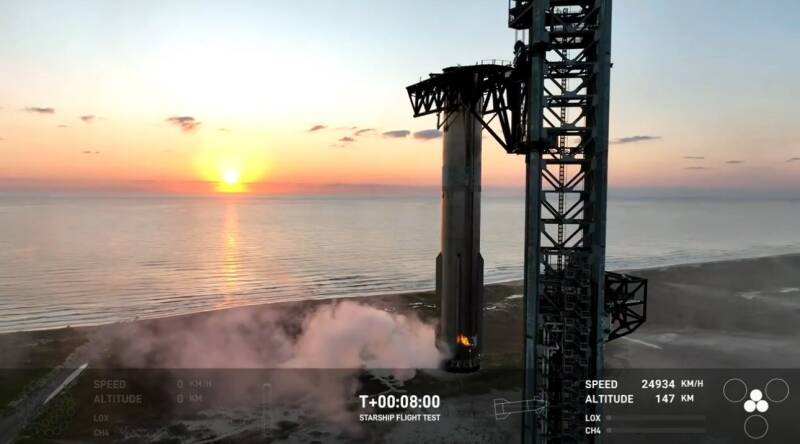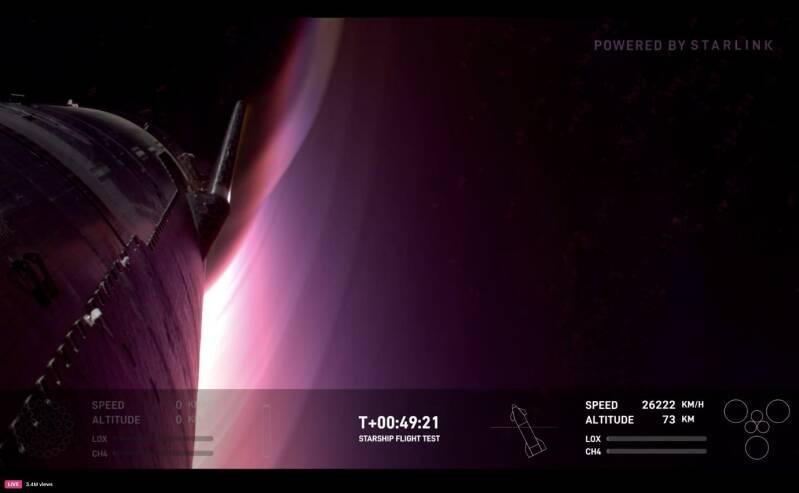Boca Chica, Texas – SpaceX has once again made history with the successful launch and landing of its Starship rocket during its fifth test flight on October 13, 2024. The mission, which took place at SpaceX's Starbase facility, saw the most powerful rocket ever built, the Starship, soar into the skies at 8:25 a.m. ET.

Credit: SpaceX
The Launch
The highlight of this test flight was the unprecedented achievement of safely landing the rocket's first-stage booster, known as Super Heavy, back at the launch site. The 400-foot-tall (122 meters) booster was caught mid-air by a set of massive metal arms, affectionately referred to as "chopsticks," which were specially designed for this bold maneuver.
Technical Details
The Super Heavy booster is powered by 33 methane-fueled Raptor engines, generating nearly 17 million pounds of thrust, more than twice the power of NASA’s Saturn V rocket from the Apollo lunar program This immense power allowed the rocket to reach an altitude of approximately 100 kilometers (62 miles) before the booster separated and began its return journey to the launch site.

Credit: SpaceX
The Catch
Today’s flight test, which was delayed 25 minutes while SpaceX waited for its launch range to be cleared of boats, marks the second full Starship launch, flight, and return to Earth. The starship reentered the Earth’s atmosphere about 45 minutes after liftoff and carried out a “soft” splashdown in the Indian Ocean at 9:30AM ET. An explosion rocked the craft just after that.

Credit: SpaceX
SpaceX redesigned Starship’s heat shield for this test after Starship lost fragments of its shielding during reentry during previous test flight in June. SpaceX used new heat shielding tiles especially around flap joints and added an extra backup ablative layer underneath the hexagonal heat tiles.
The booster's return was a complex process involving multiple stages. After the separation, the booster performed a series of engine burns to slow down and reorient itself for the landing. As it approached the launch site, the "chopsticks" arms extended to catch the booster mid-air, preventing a hard landing and ensuring its structural integrity.
Elon Musk, the founder and CEO of SpaceX, has been vocal about the company's goal to make space travel more sustainable and cost-effective. The Starship rocket is a crucial part of this vision, with plans to use it for future missions to the moon and Mars. The successful landing of the Super Heavy booster is a step closer to achieving these ambitious goals.
The Federal Aviation Administration (FAA) gave SpaceX approval for the test flight just one day before the launch. The Federal Aviation Administration (FAA) issued SpaceX with a license for this test flight, which was conducted sooner than expected. It had originally expected to clear this launch in November. The mission was not only a technical success but also a testament to the rapid progress SpaceX has made in the field of aerospace engineering.
As the world watched the official live broadcast of the launch and landing, SpaceX's communications manager, Dan Huot, expressed his amazement at the successful catch, saying, "What we just saw, that looked like something out of science fiction!"
With this achievement, SpaceX continues to push the boundaries of what is possible in space travel, bringing us closer to a future where space exploration is more accessible and routine.


Add comment
Comments
elon keep going your work is is perfect in my eyes your making a childhood dreams come true